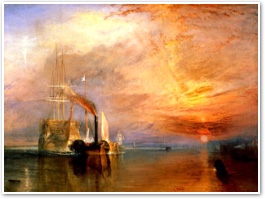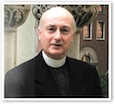Crepuscule
- FATHER GEORGE RUTLER
A difficult time of day for artists to depict is what in French is called crepuscule: the tenuous light that quivers like mercury just before dawn and like old gold as shadows lengthen.
 For the dawn, the painter needs Zinc White and Cadmium Yellow, and for the evening twilight, Titanium White and Yellow Ochre and other colors that most artists guard as closely as a chef his recipes.
For the dawn, the painter needs Zinc White and Cadmium Yellow, and for the evening twilight, Titanium White and Yellow Ochre and other colors that most artists guard as closely as a chef his recipes.
Children used to know Longfellow's "The Children's Hour," which my own mother taught me from the memory bank of her childhood: "Between the dark and the daylight, / When the night is beginning to lower ..." Ten years after the American poet wrote that, John Ellerton in England wrote the emotive hymn: "The day Thou gavest, Lord, is ended, / The darkness falls at Thy behest ..."
At twilight, our Lord appeared to two men on the road to Emmaus. The sinking sun was like their sinking spirits, until they recognized the Master who had risen, as he had made the sun to rise on the fourth day: "Evening came, and morning followed…" (Genesis 1:19).
In the thirteenth century, Pope Gregory IX wrote that "the evening of the world is now declining," and he thought that time itself would soon end. But the setting of the sun is prelude to its rising, and in the darkness of Good Friday was a rumor of expectation. Even our national lore links dawn with promise: "… by the dawn's early light . . . at the twilight's last gleaming…" Ellerton's hymn about sunset senses what was going on in other parts of empire: "The sun that bids us rest is waking / Our brethren 'neath the western sky…"
Gospel accounts are ambiguous about when the women discovered the empty tomb. John says it was "very early, while it was yet dark." Saint Augustine, with his typical common sense, decided that Matthew's account of the "end of the Sabbath" might simply be another way of describing what the other Evangelists recounted. Those hours clocked a change in the whole world. Christ predicted the moral confusion of those who would deny the Resurrection when it happened in their own precinct: "When evening comes, you say, 'The weather will be fair, for the sky is red; and in the morning, 'Today it will be stormy, for the sky is red and overcast.' You know how to interpret the appearance of the sky, but not the signs of the times!" (Matthew 16:2-3).
In dark days, Churchill found solace in his paint box. He averred that if there is a Heaven, he would spend the first ten thousand years there painting pictures in the brightest colors. Without any intention of irreverence, one may indulge an image of the Risen Lord opening a celestial paint box and saying, as Turner said to a woman who complained that she had never seen a sky that looked the way he painted it: "Perhaps so, but don't you wish you had?"
 This is Meaghen Gonzalez, Editor of CERC. I hope you appreciated this piece. We curate these articles especially for believers like you.
This is Meaghen Gonzalez, Editor of CERC. I hope you appreciated this piece. We curate these articles especially for believers like you.
Please show your appreciation by making a $3 donation. CERC is entirely reader supported.

Acknowledgement
 Father George W. Rutler. "Crepuscule." From the Pastor (April 9, 2018).
Father George W. Rutler. "Crepuscule." From the Pastor (April 9, 2018).
Reprinted with permission from Father George W. Rutler.
The Author
 Father George W. Rutler is the pastor of St. Michael's church in New York City. He has written many books, including: The Wit and Wisdom of Father George Rutler, The Stories of Hymns, Hints of Heaven: The Parables of Christ and What They Mean for You, Principalities and Powers: Spiritual Combat 1942-1943, Cloud of Witnesses — Dead People I Knew When They Were Alive, Coincidentally: Unserious Reflections on Trivial Connections, A Crisis of Saints: Essays on People and Principles, Brightest and Best, and Adam Danced: The Cross and the Seven Deadly Sins.
Father George W. Rutler is the pastor of St. Michael's church in New York City. He has written many books, including: The Wit and Wisdom of Father George Rutler, The Stories of Hymns, Hints of Heaven: The Parables of Christ and What They Mean for You, Principalities and Powers: Spiritual Combat 1942-1943, Cloud of Witnesses — Dead People I Knew When They Were Alive, Coincidentally: Unserious Reflections on Trivial Connections, A Crisis of Saints: Essays on People and Principles, Brightest and Best, and Adam Danced: The Cross and the Seven Deadly Sins.




